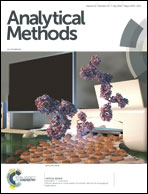A sensitive three-signal assay for the determination of PFOS based on the interaction with Nile blue A†
Abstract
In this work, a sensitive three-signal assay of perfluorooctanesulfonic acid (PFOS) was proposed. In pH 3.3 Britton–Robinson (BR) buffer solution, perfluorooctane sulfonate anions can react with Nile blue A (NBA) through electrostatic attraction and hydrophobic force to form 1 : 1 ion-association complexes resulting in intensity changes in the fluorescence, UV-vis absorption and resonance light scattering (RLS). There was found to be a certain relationship between the three signal changes dependent upon the concentration of PFOS. The change of absorption of NBA is proportional to the logarithm of the concentration of PFOS in the range of 0.1–4.0 μmol L−1 with a limit of detection (LOD) of 14.8 nmol L−1, and RLS intensity change is proportional to the concentration of PFOS in the range of 2.0–12.0 μmol L−1 with a LOD of 119.5 nmol L−1 and the change in the fluorescence is proportional to the logarithm of the concentration of PFOS in the range of 0.05–4.0 μmol L−1 with a LOD of 3.2 nmol L−1. Scanning electron microscopy (SEM) and zeta potential measurements were recorded in order to study the mechanism. This simple, sensitive and cost-effective fluorescence method was successfully applied in the determination of PFOS in real water samples with RSD values of ≤2.14%.



 Please wait while we load your content...
Please wait while we load your content...